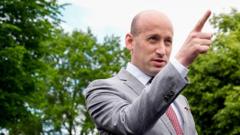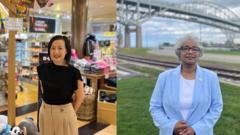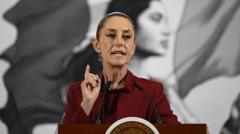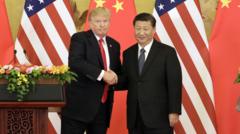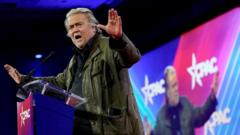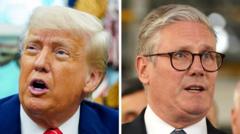The latest electoral battle in Canada is marked by rising tensions, shifting allegiances, and a desperate bid for control between the leading parties as they face off against the backdrop of international pressures and domestic discontent.
**Historic Election in Canada: A Last-Minute Turnaround Shapes Political Landscape**
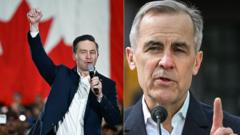
**Historic Election in Canada: A Last-Minute Turnaround Shapes Political Landscape**
In the final hours of Canada's election campaign, critical shifts in public sentiment and party dynamics are becoming evident.
At a rally in London, Ontario, Liberal leader Mark Carney faced a mixed reception as he urged supporters to recognize the threat posed by America under President Trump. "President Trump wants to undermine us to assert dominance," he declared, to which the crowd fervently responded, "Never." Many attendees showcased their national pride, brandishing Canadian flags atop hockey sticks.
Meanwhile, Conservative leader Pierre Poilievre energized his supporters in the Toronto area, rallying the crowd with a message focused on changing the government amidst a rise in Canadian nationalism, particularly in light of U.S. tariffs. His campaign slogan, "Bring it Home," resonates deeply as voters grapple with economic stability and national identity.
With the election looming, Trump’s influence is palpably felt, as the party that convincingly presents its strategy on navigating U.S.-Canada relations is poised for electoral success. Current polls indicate that the Liberals are maintaining a slight edge against the Conservatives as voters reflect on their allegiances.
Although Trump is a significant factor, the Liberals are presenting a broader critique of the government’s past decade. Poilievre's criticism of the Liberal administration taps into a collective frustration with the housing crisis and rising crime rates, motivating disillusioned voters in places like Barrie, Ontario. Some voters, such as Eric and Carri Gionet, are attending rallies for the first time, hoping for a change that assures better prospects for younger generations as they fear for their children’s future.
The tides began to shift for the Liberals at the start of this year following a surprising resignation from Justin Trudeau, leading to Carney's ascendance as a united front amid a rising tide of dissatisfaction. His experience in managing economic crises makes him a compelling candidate, transforming the once-flagging Liberal movement into a contender for a fourth consecutive term.
Voter sentiments reveal a diverging view on Carney's candidacy, with some viewing him as a potential harbinger of change. “It’s impressive,” said Mike Brennan from Kitchener. Conversely, veteran Conservative supporter Gwendolyn Slover perceives the ongoing support for Carney as unfounded given he belongs to the same party as Trudeau.
The looming shadow of Trump has catalyzed Conservative voters to rally behind Poilievre, who has tried to differentiate himself from the U.S. president while maintaining a combative posture on campus-related issues. Poilievre’s ability to articulate a clearer vision appears challenged amid a rapidly changing political environment.
As both major parties gear up for the close of the campaign, there is concern over smaller parties squandering potential electoral support. Both Liberals and Conservatives are vying for more than 38% of the national vote, a scenario last seen in the 1975 elections.
With deep ideological rifts emerging and substantial issues such as climate change and indigenous rights relegated to a backseat, the parties focus intensively on economic issues. Both frontrunners agree on the basic needs, pointing to a common aim of reducing dependency on the U.S. while advancing domestic resource sectors.
As the campaign wraps up, Carney appeals for seasoned leadership, urging voters that, "Experience, not experiments, is vital," while Poilievre calls for transformative change, promising a bright outlook ahead. The next days may reveal the potential for a historic political shift, forcing voters to reflect closely on their choices as they head to the polls.

